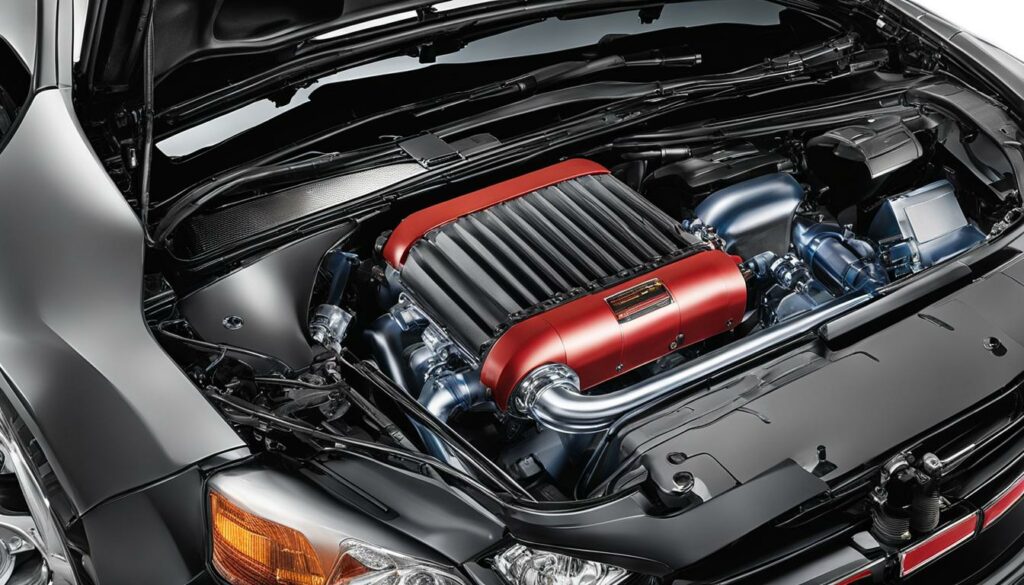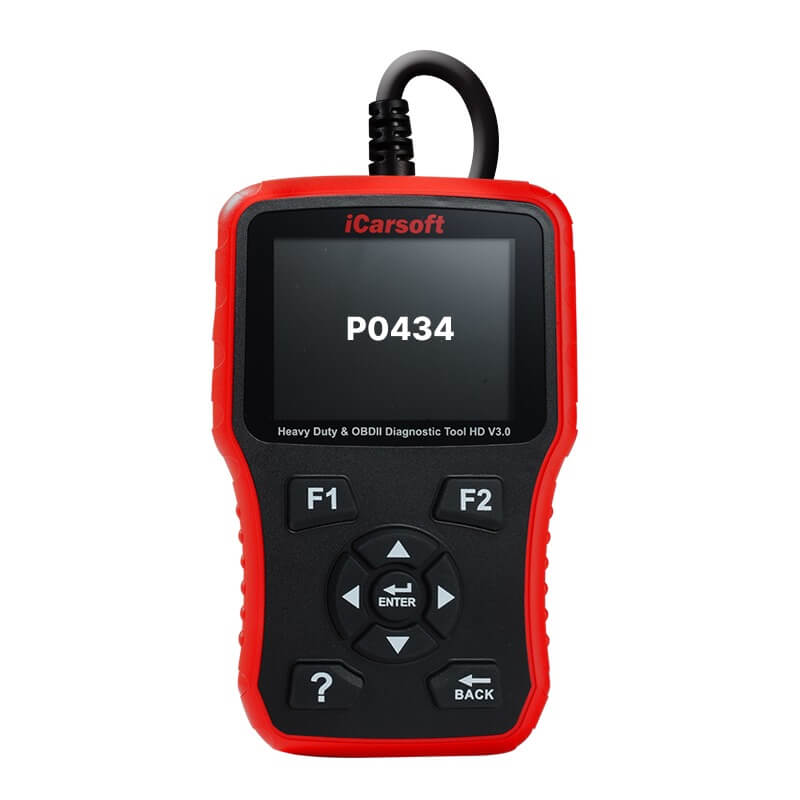P0434 – Heated Catalyst Temperature Below Threshold Bank 2
POSTED IN pcodes
Welcome to our article on the P0434 engine code, specifically addressing the issue of heated catalyst temperature being below the threshold for Bank 2. This diagnostic trouble code is related to the catalytic converter and can have significant implications for your vehicle’s performance and emissions control system.
When your vehicle’s computer detects the P0434 code, it means that there is a temperature variance in the catalytic converter, indicating that it is not functioning properly. The catalytic converter plays a crucial role in reducing harmful emissions by converting them into less harmful substances. However, when it fails to operate at the required temperature, it cannot effectively perform this function.
There are several underlying causes for the P0434 code, with a failed catalytic converter being the most common one. Other potential culprits include a failed oxygen sensor, an air leak in the exhaust system before the catalytic converter, using the wrong grade of gasoline consistently, or faulty sensors and regulators affecting the fuel system and coolant temperature.
It’s important to address the P0434 code promptly, as it can lead to reduced fuel economy, engine hesitation, and overall diminished engine performance. Additionally, the vehicle may fail an emissions inspection, as the catalytic converter is not effectively reducing harmful pollutants.
Diagnosing the P0434 code involves connecting your vehicle to an OBD II scanner, testing the catalytic converter for warranty coverage, replacing any faulty oxygen sensors, performing an exhaust leak test, and inspecting the wiring and connections. It may also be necessary to verify the power supply and temperature during operation using a voltmeter and heat gun.
Buy tested tuning file for Adblue / EGR / DPF / Adblue off now!
To illustrate the severity and symptoms of the P0434 code, we have provided an image below:
Key Takeaways:
- The P0434 code indicates a temperature variance in the catalytic converter, specifically Bank 2.
- A failed catalytic converter is the most common cause, but other potential causes include failed oxygen sensors, exhaust leaks, and fuel system issues.
- Symptoms of the P0434 code include reduced fuel economy, engine hesitation, and a hissing sound on acceleration.
- Diagnostic steps involve using an OBD II scanner, performing tests, inspecting wiring, and verifying power supply and temperature during operation.
- It is recommended to seek professional assistance when diagnosing and repairing the P0434 code to ensure accurate diagnosis and proper repairs.
Understanding the Impact of P0434 on Emissions
The P0434 code indicates that the catalytic converter is not functioning properly, which can have a negative impact on emissions. The catalytic converter plays a crucial role in the emission control system of a vehicle, as it is responsible for reducing harmful pollutants in the exhaust gases. It accomplishes this by using a catalyst to convert carbon monoxide, nitrogen oxides, and unburned hydrocarbons into carbon dioxide, nitrogen, and water vapor.
When the catalytic converter is not working correctly, it cannot effectively convert these harmful emissions, leading to higher levels of pollutants being released into the environment. This can have detrimental effects on air quality and contribute to environmental pollution.
Image:

Passing emissions tests is an important requirement for vehicles to comply with environmental regulations. A vehicle with a faulty catalytic converter is likely to fail these tests, indicating that it is not effectively reducing emissions. This not only poses a risk to the environment but also puts the vehicle owner at risk of fines or penalties for violating emissions standards.
Therefore, it is crucial to address the P0434 code and ensure that the catalytic converter is repaired or replaced properly. By doing so, you can contribute to cleaner air and a healthier environment, while also ensuring that your vehicle meets the necessary emissions requirements.
How to Address the P0434 Engine Code Effectively
When faced with the P0434 engine code, there are steps you can take to address the issue effectively. Follow these troubleshooting steps to diagnose and resolve the problem:
- Use an OBD II scanner to read and clear the code. This will help determine if the code is a temporary glitch or a persistent issue.
- If the P0434 code reappears, check if the catalytic converter is still under warranty from the manufacturer. If it is, consult with the manufacturer or an authorized dealer for repair or replacement options.
- If there is an oxygen sensor code in addition to P0434, replace the oxygen sensor before proceeding with further diagnostics. Faulty oxygen sensors can affect the performance of the catalytic converter.
- Perform an exhaust leak test to identify any leaks in the exhaust system that may be contributing to the code. Repair any leaks found to ensure proper operation of the catalytic converter.
- Visually inspect the wiring and connections to the catalytic converter. Look for any signs of damage or corrosion that may be affecting the converter’s performance. Repair or replace any damaged components as necessary.
- Use a voltmeter and heat gun to verify the proper power supply and temperature during the operation of the catalytic converter. This will help diagnose any issues with power delivery or temperature regulation.
If you are unsure about any of these troubleshooting steps or if a professional mechanic is unavailable, it is recommended to seek professional assistance. A qualified technician will have the expertise and tools necessary to diagnose and repair the P0434 code effectively. They can help identify the underlying cause of the issue and perform the necessary repairs to restore your vehicle’s performance.
Alternatively, if professional assistance is not readily available, you may consider uploading your Engine Control Unit (ECU) file to a specialized portal for the permanent removal of the P0434 code. However, this should only be done after careful consideration and consultation with experts.
Understanding the Severity and Symptoms of the P0434 Code
While the P0434 code might not create immediate drivability problems, it is important to address it due to the potential impact on fuel economy and emissions. The severity of the code lies in the fact that it can prevent the vehicle from passing an emissions inspection and may result in lower fuel efficiency.
Symptoms of the P0434 code include:
- Check Engine light illuminating
- Reduced fuel economy
- Engine hesitation
- Reduced engine performance
- A hissing sound on acceleration
If you notice any of these symptoms or if the Check Engine light is on, it is best to have the code diagnosed and the necessary repairs performed to ensure optimal vehicle performance.
Common Mistakes and Best Practices When Diagnosing the P0434 Code
When faced with the P0434 engine code, it’s crucial to avoid common mistakes that could lead to misdiagnosis and unnecessary repairs. The most common mistake is assuming that the code automatically indicates a faulty catalytic converter. While a failed converter is a possibility, there are other potential causes for the code, such as a failed oxygen sensor or an air leak in the exhaust system.
It is essential to eliminate all other potential causes before replacing the catalytic converter.
To effectively diagnose and address the P0434 code, it is recommended to follow these best practices:
- Conduct a full diagnostic: Start by connecting the car to an OBD II scanner and reading the codes. Perform additional tests and inspections to identify any underlying issues.
- Clear codes and test after each repair: After addressing a potential cause, clear the codes and test the vehicle again to ensure the code does not reappear. This helps verify the effectiveness of the repair.
- Utilize appropriate diagnostic tools and equipment: Having the right tools and equipment is crucial for accurate diagnosis. Use specialized equipment and follow manufacturer guidelines to ensure proper diagnostics.
By following these best practices, you can avoid unnecessary repairs and ensure that the root cause of the P0434 code is diagnosed and addressed accurately. When in doubt or if you lack the necessary expertise, it is always recommended to consult a professional mechanic or seek professional assistance.
“Eliminating all potential causes before replacing the catalytic converter is essential to avoid unnecessary expenses and ineffective repairs.”
To further illustrate the importance of diagnosing the P0434 code correctly, let’s take a look at the following table:
| Potential Causes | Severity |
|---|---|
| Failed catalytic converter | High |
| Failed oxygen sensor | Medium |
| Air leak in the exhaust system | Low |

As shown in the table above, while a failed catalytic converter has a high severity, it is not the only potential cause. Misdiagnosing the issue and immediately replacing the converter can result in unnecessary expenses and ineffective repairs.
Importance of Consulting Professionals
Diagnosing and repairing the P0434 code can be complex, especially for inexperienced individuals. Seeking the assistance of a professional mechanic ensures accurate diagnosis and proper repairs. Professionals have the knowledge, experience, and specialized tools to tackle the issue effectively.
“Consulting professionals ensures accurate diagnosis and proper repairs, saving time and money.”
In summary, avoiding common mistakes and following best practices when diagnosing the P0434 code is crucial for accurate and cost-effective repairs. By eliminating all potential causes and utilizing appropriate diagnostic tools, you can address the root cause of the code, whether it’s a failed catalytic converter, oxygen sensor, or an air leak. Consulting professionals ensures accurate diagnosis and proper repairs, saving time and money in the process.
Conclusion
In conclusion, the P0434 code indicates a temperature variance in the catalytic converter bank 2. This issue can lead to various problems, including drivability issues, lower fuel economy, and difficulties passing emissions inspections. While a failed catalytic converter is the most common cause of the code, it is essential to consider other potential causes, such as a failed oxygen sensor or an air leak in the exhaust system.
To address the P0434 code effectively, proper diagnosis and repairs are necessary. It is recommended to seek professional assistance to ensure accurate diagnosis and appropriate repairs. However, if professional help is unavailable, there are alternative solutions, such as removing the P0434 code by uploading the Engine Control Unit (ECU) file to a specialized portal.
It is crucial to address the P0434 code to ensure optimal vehicle performance, reduce emissions, and pass emissions tests. By taking the necessary steps to diagnose and repair the issue, you can resolve the temperature variance in the catalytic converter bank 2 and restore your vehicle’s efficiency and compliance with environmental regulations.
FAQ
What does the P0434 code mean?
The P0434 code indicates that the car’s computer has detected a temperature variance in the catalytic converter. This means that the catalytic converter is not working properly and is not burning harmful emissions as it is designed to do.
What are the symptoms of the P0434 code?
Symptoms of the P0434 code include the Check Engine light illuminating, reduced fuel economy, engine hesitation, reduced engine performance, and a hissing sound on acceleration.
What are the possible causes of the P0434 code?
The most common cause of the P0434 code is a failed catalytic converter. Other possible causes include a failed oxygen sensor, an air leak in the exhaust before the catalytic converter, using the wrong grade of gasoline consistently, or faulty sensors such as the coolant temperature sensor, manifold air pressure sensor, or fuel pressure regulator causing excessive fuel to enter the exhaust.
How can I diagnose the P0434 code?
Diagnosing the P0434 code involves connecting the car to an OBD II scanner, testing the catalytic converter for warranty coverage, replacing any faulty oxygen sensors, performing an exhaust leak test, visually inspecting wiring and connections, and using a voltmeter and heat gun to verify proper power supply and temperature during operation.
What is the severity of the P0434 code?
While the P0434 code might not create immediate drivability problems, it can prevent the vehicle from passing an emissions inspection and may result in lower fuel efficiency.
What are the best practices for diagnosing the P0434 code?
Best practices for diagnosing the P0434 code include conducting a full diagnostic, clearing codes and testing the vehicle after each repair, and utilizing the appropriate diagnostic tools and equipment.


